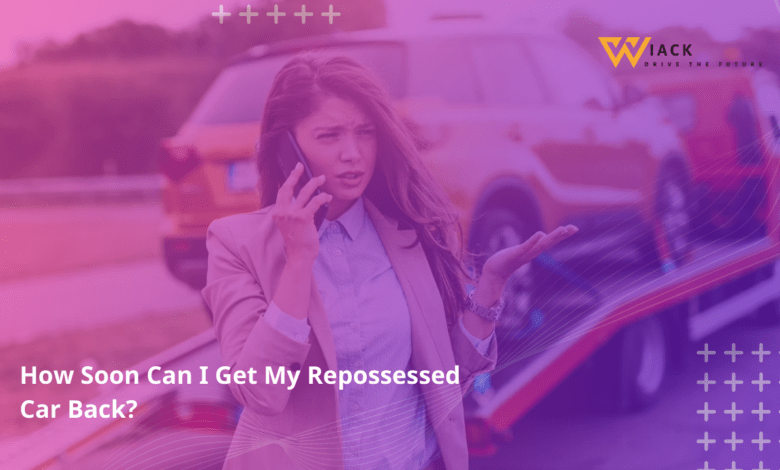How Soon Can I Get My Repossessed Car Back?

Did you know that over 1.7 million vehicles are repossessed in the United States each year? This staggering statistic highlights the prevalence of car repossessions and the importance of understanding your options if you find yourself in this challenging situation. If you’re wondering, “How soon can I get my repossessed car back?” you’re not alone. In this comprehensive guide, we’ll explore the timelines, options, and steps you can take to potentially reclaim your vehicle after repossession.
Understanding Your Rights and Options
When your car is repossessed, it can feel like you’ve lost all control. However, you still have rights and options available to you. Understanding these can help you navigate the process more effectively and potentially get your car back sooner.
What Happens After Repossession?
After your car is repossessed, a series of events unfolds:
- The lender takes possession of your vehicle, often without prior notice.
- You should receive a “Notice of Intent to Sell Property” from the lender within a specific timeframe (varies by state).
- The lender prepares to sell the vehicle, typically at auction.
- You have a limited window to take action before the sale occurs.
It’s crucial to act quickly once you realize your car has been repossessed. The clock starts ticking immediately, and your options may become more limited as time passes.
Can I Get My Repossessed Car Back?
The short answer is yes, in many cases you can get your repossessed car back. However, the process and timeline can vary depending on your specific situation and the options available to you. Let’s explore the main ways you might be able to reclaim your vehicle:
Reinstatement: Reviving Your Loan
Reinstatement is often the quickest and most straightforward way to get your car back after repossession. This process involves:
- Bringing your loan current by paying all past-due amounts
- Covering any repossession fees and related costs
- Resuming regular payments on your loan
Here’s what you need to know about reinstatement:
- Not all lenders offer reinstatement, so check your loan agreement or state laws.
- You typically have a short window to reinstate, often 15-30 days after repossession.
- You’ll need to act quickly and have the funds available to cover all past-due amounts and fees.
If reinstatement is an option for you, it can be the fastest way to get your car back, often within a few days of making the necessary payments.
Redemption: Buying Back Your Car
Redemption involves paying off the entire remaining balance of your loan, plus any repossession fees and related costs. While this option can be more challenging financially, it does offer some advantages:
- You own the car outright after redemption, with no more loan payments.
- You may be able to redeem the vehicle right up until it’s sold at auction.
- Some states require lenders to give you a specific redemption period.
The timeline for redemption can vary, but it’s often possible to redeem your vehicle within a week or two of repossession if you can secure the necessary funds quickly.
Buying at Auction: A Potential Alternative
If you can’t reinstate or redeem your loan, you might still have a chance to get your car back by buying it at the auction where the lender plans to sell it. Here’s what you should know:
- You’ll need to outbid other buyers to reclaim your vehicle.
- The auction typically happens within 10-45 days after repossession.
- You’ll need to have the funds ready to pay for the car immediately if you win the bid.
While this option can be risky and potentially more expensive, it might be your last chance to get your specific vehicle back if other options aren’t available or feasible for you.
Timeframes for Getting Your Car Back
When you’re trying to reclaim your repossessed vehicle, time is of the essence. Understanding the typical timeframes for each option can help you plan and act more effectively.
Reinstatement Deadlines
The deadline for reinstating your loan can vary significantly depending on your state laws and lender policies. Here’s a general overview:
- Some states require lenders to offer a reinstatement period of 15-30 days after repossession.
- In states without specific laws, the reinstatement period is typically outlined in your loan agreement.
- Reinstatement periods can be as short as 10 days or as long as 45 days, depending on the circumstances.
It’s crucial to check your specific state laws and loan agreement to determine your exact reinstatement deadline. Here’s a table showing some example state reinstatement periods:
| State | Typical Reinstatement Period |
|---|---|
| California | 15 days |
| Florida | 10 days |
| New York | 30 days |
| Texas | No specific law, check loan agreement |
Remember, these are general guidelines, and your specific situation may differ. Always verify the exact deadline with your lender or a legal professional.
Redemption Timeframes
The redemption period, during which you can pay off your loan in full to reclaim your vehicle, often extends until the car is sold. However, the exact timeframe can vary:
- Some states require a specific redemption period, often 10-15 days after repossession.
- In other cases, you may be able to redeem your vehicle right up until it’s sold at auction.
- Auctions typically occur within 10-45 days after repossession, depending on state laws and lender practices.
To maximize your chances of redemption, it’s best to act as quickly as possible after repossession. The sooner you can secure the funds to pay off your loan, the more likely you are to successfully redeem your vehicle.
Factors Affecting the Timeline
Several factors can influence how quickly you can get your repossessed car back. Understanding these can help you navigate the process more effectively and potentially speed up your car’s return.
State Laws and Regulations
State laws play a significant role in determining the timeline for reclaiming your repossessed vehicle. Here are some key points to consider:
- Some states require lenders to provide a “cure period” during which you can bring your loan current and reclaim your car.
- Certain states mandate specific notice periods before a lender can sell a repossessed vehicle.
- Consumer protection laws in some states may provide additional rights or timeframes for borrowers.
It’s essential to research the specific laws in your state or consult with a legal professional to understand how local regulations might affect your timeline.
Lender Policies and Procedures
Each lender has its own policies and procedures for handling repossessions, which can impact how quickly you can get your car back:
- Some lenders may be more willing to work with borrowers on reinstatement or redemption options.
- The speed at which a lender processes paperwork and payments can affect your timeline.
- Lender policies on auction scheduling and sale procedures can influence how much time you have to reclaim your vehicle.
To navigate these policies effectively:
- Contact your lender immediately after repossession.
- Ask for a detailed explanation of their repossession procedures and timelines.
- Inquire about any flexibility they might offer in terms of reinstatement or redemption.
Auction Schedule and Timing
The timing of the auction where your repossessed car will be sold can significantly impact your window for reclaiming the vehicle:
- Auctions are typically scheduled within 10-45 days after repossession.
- Some lenders have regular auction schedules, while others may vary based on inventory.
- The location and type of auction (public or dealer-only) can affect the timing.
To stay informed about the auction timing:
- Ask your lender for the specific date, time, and location of the planned auction.
- If possible, request to be notified of any changes to the auction schedule.
- Keep in mind that once the auction occurs, your options for reclaiming the specific vehicle are typically exhausted.
Tips for Speeding Up the Process
If you’re eager to get your repossessed car back as quickly as possible, there are several steps you can take to potentially expedite the process. Here are some valuable tips to consider:
Communicate with Your Lender
Open and proactive communication with your lender is crucial for a speedy resolution. Here’s how to make the most of your interactions:
- Contact your lender immediately after repossession.
- Be honest about your financial situation and willingness to resolve the issue.
- Ask about all available options for reclaiming your vehicle.
- Request specific timelines and deadlines for each option.
- Keep detailed records of all conversations, including dates, times, and names of representatives you speak with.
Remember, lenders often prefer to work out a solution rather than go through the costly process of selling your car at auction. By demonstrating your commitment to resolving the situation, you may find your lender more willing to expedite the process.
Gather Necessary Documentation
Having all required documentation ready can significantly speed up the process of reclaiming your car. Prepare the following:
- Proof of income (pay stubs, bank statements, etc.)
- Identification (driver’s license, state ID)
- Loan account information
- Any correspondence from the lender regarding the repossession
- Proof of insurance
By having these documents on hand, you can quickly respond to any requests from your lender, potentially shaving days off the process.
Secure Financing if Needed
If you need to secure funds to reinstate your loan or redeem your vehicle, start working on this immediately:
- Explore personal loan options from banks or credit unions.
- Consider borrowing from family or friends if possible.
- Look into alternative financing options, such as peer-to-peer lending platforms.
- If applicable, check if you can access funds from retirement accounts or other investments.
The faster you can secure the necessary funds, the sooner you may be able to reclaim your vehicle. However, be cautious about taking on additional debt that you may struggle to repay.
What if I Can’t Get My Car Back?
Sometimes, despite your best efforts, you may not be able to reclaim your repossessed vehicle. If this is the case, it’s important to understand your options and how to move forward.
Exploring Other Transportation Options
Losing your car can be a significant disruption to your daily life, but there are alternative transportation methods to consider:
- Public transportation: Research bus and train routes in your area.
- Carpooling: Ask colleagues or neighbors about sharing rides.
- Bicycling: For shorter distances, cycling can be a healthy and cost-effective option.
- Ride-sharing services: Services like Uber or Lyft can fill transportation gaps.
- Car-sharing programs: Look into services like Zipcar for occasional car use.
While these options may not be as convenient as having your own car, they can help you manage your transportation needs while you work on improving your financial situation.
Protecting Your Credit
A repossession can have a significant negative impact on your credit score. Here are some steps to minimize the damage and start rebuilding your credit:
- Continue making payments on other debts to maintain a positive payment history.
- Consider working with a credit counselor to develop a plan for improving your credit.
- Monitor your credit reports regularly and dispute any inaccuracies.
- Look into secured credit cards or credit-builder loans to help rebuild your credit over time.
Remember, while a repossession can stay on your credit report for up to seven years, its impact diminishes over time, especially if you take proactive steps to improve your credit.
Moving Forward Financially
After a repossession, it’s crucial to reassess your financial situation and make plans for the future:
- Create a detailed budget to understand your income and expenses.
- Look for ways to increase your income or reduce expenses.
- Start building an emergency fund to help prevent future financial crises.
- Consider working with a financial advisor to develop long-term financial goals and strategies.
By taking these steps, you can work towards financial stability and potentially avoid similar situations in the future.
In conclusion, while the question “How soon can I get my repossessed car back?” doesn’t have a one-size-fits-all answer, understanding your rights, options, and the factors that influence the timeline can help you navigate this challenging situation more effectively. Remember, time is of the essence when dealing with a repossession, so act quickly and decisively. Whether you’re able to reclaim your vehicle or need to explore alternative options, use this experience as a catalyst for improving your financial health and planning for a more stable future.
Get the latest car news, reviews, and prices at Wiack.com. Your one-stop destination for all things automotive.





